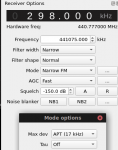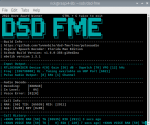Mid June Update
Any current users of DSD-FME will need to switch over to using the executable name
dsd-fme instead of
dsd after pulling the latest update. I've taken the opportunity to switch over the executable name to the project name to alleviate any sort of confusion between this version of dsd and others out there. I fear it may cause a little confusion at first though, as the binary executable for dsd may still be in your /usr/local/bin/ directory and can still be called, along with the current iteration of the dsd-fme binary executable. It is advised to open your current dsd-fme/build folder and run
sudo make uninstallfirst, or to manually remove the binary with
sudo rm /usr/local/bin/dsd if you have already run a git pull and updated the software. An upside to this change is that other github versions of dsd can also be used and installed without clashing with this version.
The full notice on this change and additional information can be found
here.
I have also reworked the install scripts slightly, offering a little more variety regarding if you are building for the first time and want to automatically build and install all dependencies(Debian/Ubuntu/Mint/Pi), whether or not you want to just clone and build DSD-FME by itself if you already have the dependencies, use another distro type and need to install dependencies in another manner, or or install if you already have the software cloned or if you need to do a git pull and update. More information can be read regarding these changes and procedures for cloning, building, and installing DSD-FME
here.
Updates, Improvements, Changes
The current iteration has seen a big code clean up, removing tons of files in the project directories regarding github workflows, travis containers, test building, and other superfluous directories, slimming the project folder down a nice considerable bit. The CMakeLists.txt will now only build and install dsd-fme and not build the tests as I really don't expect any particular user would use those features. Even I don't use them in development. This speeds up build times by a nice little bit, especially on lower powered machines, Pi, and VMs with limited allocation of resources.
I've also slightly tweaked the pulseaudio output, regarding the application name itself. Prior, pulseaudio server would remember changes made to output streams, but if a user were to switch between the DMR Stereo method -T or use different decoding, it wouldn't remember the left/right channel configuration so I've exploited this by created different stream names for DMR Stereo Slot 1 and Slot 2 so pulseaudio server will remember the left channel and right channel and audio levels when switching between decoding.
If audio is broken for you, go into pavucontrol and check to see if audio is still routed out properly.
Other than that, its just minor little tweaks to the back-end of the software, mostly small timing changes in the order of events for DMR Stereo specifically.
How to Install the latest version
New Users on Debian/Ubuntu/Mint/Pi can run the auto installer to install all dependencies and build and install DSD-FME for them. (Headless users should use the manual method instead as a few dependencies will vary slightly)
Code:
wget https://raw.githubusercontent.com/lwvmobile/dsd-fme/pulseaudio/download-and-install.sh
chmod +x download-and-install.sh
./download-and-install.sh
Current users who need to do a update install can simply run the rebuild.sh script inside their current dsd-fme folder. Should this method fail, then you may use the download-and-install-nodeps.sh file inside of a clean folder to do a fresh clean install instead. It is advised to run
sudo make uninstall inside of your current build folder first, or to run
sudo rm /usr/local/bin/dsd after installing if you find yourself accidentally using the command dsd and not dsd-fme.
Code:
wget https://raw.githubusercontent.com/lwvmobile/dsd-fme/pulseaudio/download-and-install-nodeps.sh
chmod +x download-and-install-nodeps.sh
./download-and-install-nodeps.sh
The project link:
Digital Speech Decoder. Contribute to lwvmobile/dsd-fme development by creating an account on GitHub.

github.com










